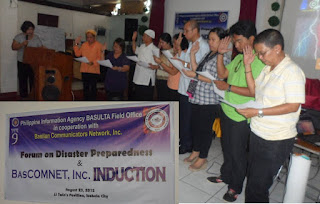by Rene V. Carbayas
ISABELA CITY, Basilan, Aug 27 (PIA) – The
Basilan Communicators Network Inc. (BasCOMNET) conducted on Thursday a forum on
disaster preparedness in Basilan to update the different government agencies
and non-government organizations on the state of disaster preparations of the
province.
 In his lecture to some fifty agency
representative members to BasCOMNET, Engr. Allan Labayog of the Philippine
Institute of Volcanology and Seismography (PhilVolcs) underscored that the
level of awareness and logistics spell out the readiness of a particular
organization, and in this case, the local government unit in disaster
preparation.
In his lecture to some fifty agency
representative members to BasCOMNET, Engr. Allan Labayog of the Philippine
Institute of Volcanology and Seismography (PhilVolcs) underscored that the
level of awareness and logistics spell out the readiness of a particular
organization, and in this case, the local government unit in disaster
preparation.
He said that Basilan has been dealing with
human-induced disasters like the armed conflict, but when it comes to natural
disasters, he asked participants if Basilan is ready. He repeatedly asked the
question of readiness to the participants as he explained the vulnerability of
Basilan, as an island, to be struck with great natural disasters, like
earthquakes and tsunamis.
Labayog explained the origin of Basilan as a
volcanic island, which makes the island as a volcano itself in the real sense.
He said that he did not mean to scare Basileños of this reality but to alert
the people and the authorities on the very high possibility of a natural
disaster that everyone must be prepared for.
Basilan, he said, sits in between two active
trenches—the Sulu trench and Cotabato trench. Historical facts reveal that at
one point of our history, violent earthquakes in these two trenches triggered
tsunamis and destructions to life and property.
 Every September 21 of every year, Isabela
City is commemorating the rising of water (“Terremoto”) and the miraculous events
attributed to its patron saint, Santa Isabel de Portugal. Historians believed
that this celebration may have its roots at the September 21, 1897 tsunami,
triggered by a 7.5 magnitude earthquake at the Sulu trench. On August 17, 1976,
another destructive tsunami occurred as triggered at the Moro Gulf, near the
Cotabato trench.
Every September 21 of every year, Isabela
City is commemorating the rising of water (“Terremoto”) and the miraculous events
attributed to its patron saint, Santa Isabel de Portugal. Historians believed
that this celebration may have its roots at the September 21, 1897 tsunami,
triggered by a 7.5 magnitude earthquake at the Sulu trench. On August 17, 1976,
another destructive tsunami occurred as triggered at the Moro Gulf, near the
Cotabato trench.
He said that there is reason to be alarmed
and be alerted by these events because they were the last recorded destructive
events in these two trenches. It was some 115 years ago for the Sulu trench and
some 36 years ago for the Cotabato trench. And Basilan is only some 156
kilometers away from the earthquake generator (Sulu trench).
He stressed that everyone must be involved in
disaster preparation, especially families. He said that each family must have a
disaster plan too, where every member of the family must know their roles and
what to do when particular disaster strikes.
 Labayog said that institutions delivering
basic services must be doing inventory to determine their disaster response
capability. He also asked the Basilan Provincial Disaster Risk Reduction
Management Council (PDRRMC) to do the same.
Labayog said that institutions delivering
basic services must be doing inventory to determine their disaster response
capability. He also asked the Basilan Provincial Disaster Risk Reduction
Management Council (PDRRMC) to do the same.
Basilan PDRRMC point person Anwary Akalun of
the Provincial Social Welfare and Development Office (PSWDO) admitted that the
province and most of the institutions here are bereft of equipment and
logistics to elevate the province’s readiness for disasters. He said, however,
that all the necessary equipment are already enumerated and incorporated in the
PDRRMC Plan. But the plan is yet to be concurred and approved by the
Sangguniang Panlalawigan and the Governor of Basilan.
.jpg) Akalun presented to the participants the
PDDRMC Plan, which was formulated by the members of the council in a recent
workshop in Zamboanga City. “We have already the plan, what we need to do now
is to implement the plan,” he said.
Akalun presented to the participants the
PDDRMC Plan, which was formulated by the members of the council in a recent
workshop in Zamboanga City. “We have already the plan, what we need to do now
is to implement the plan,” he said.
During the forum, the newly elected officers of the
BasCOMNET were also inducted into office with MTC Judge Roncesvalles Filoteo as
inducting officer. (RVC/PIA9-ZBST)